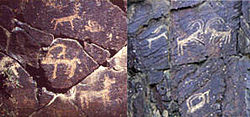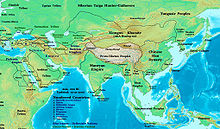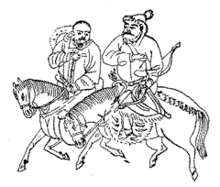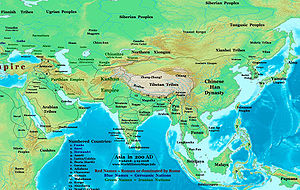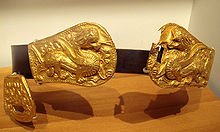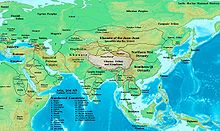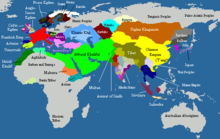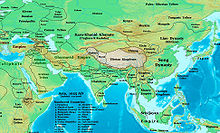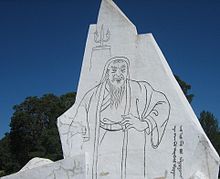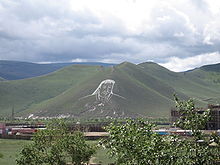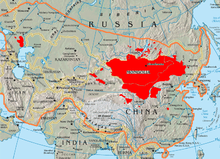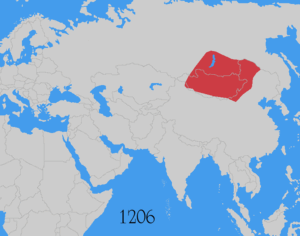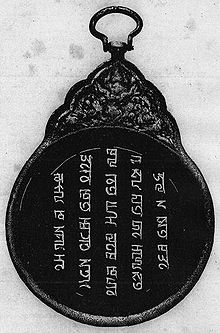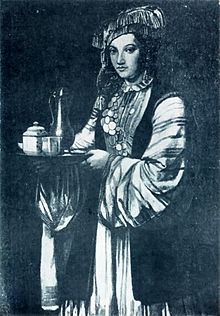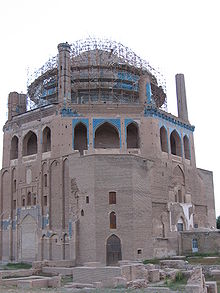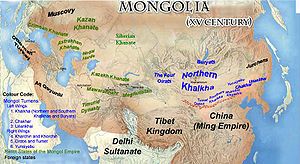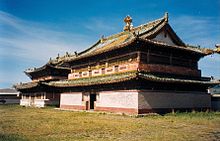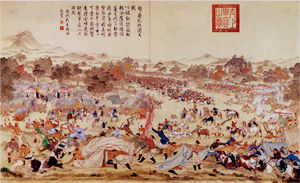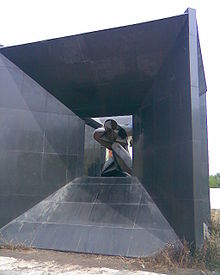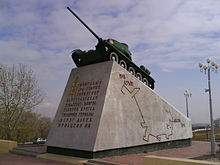- History of Mongolia
-
History of Mongolia 
This article is part of a seriesAncient History Xiongnu 209 BC-155 Xianbei 93-234 Rouran 330-555 Göktürk 552-744 Uyghur Khaganate 742-848 Yenisei Kirghiz 539-1219 Liao Dynasty 916-1125 Medieval History Khamag Mongol, Kereit, Mergid, Tatar, Naiman Mongol Empire 1206-1271 Yuan Dynasty 1271-1368 Northern Yuan Dynasty 1368-1636 Qing rule 1636/1691-1911 Modern History Independence Revolution 1911 Outer Mongolia (1911–1919) 1911-1919 Occupation of Mongolia 1919-1921 People's Revolution 1921 Mongolian People's Republic 1924-1992 Democratic Revolution 1990 Modern Mongolia 1990-present Topics Timeline of Mongolian history Culture of Mongolia Geography of Mongolia
Mongolia Portal
The area of what is now Mongolia has been ruled by various nomadic empires, including the Xiongnu, the Xianbei, the Nirun, the Gökturks, and others. The Mongol Empire was founded by Genghis Khan in 1206. After the collapse of the Yuan Dynasty in 1368, the Mongols returned to their earlier patterns of internal strife. In the 16th and 17th centuries, Mongolia came under the influence of Tibetan Buddhism. At the end of the 17th century, most of Mongolia had been incorporated into the area ruled by the Manchu Qing Dynasty. During the collapse of the Qing Dynasty in 1911, Mongolia declared independence, but had to struggle until 1921 to firmly establish de-facto independence, and until 1945 to gain international recognition. As a consequence, it came under strong Soviet influence: In 1924, the Mongolian People's Republic was declared, and Mongolian politics began to follow the same patterns as Soviet politics of the time. After the breakdown of communism in late 1989, Mongolia saw its own Democratic Revolution in early 1990, which led to a multi-party system, a new constitution in 1992, and a transition to a market economy.
Contents
- 1 Prehistory
- 2 Ancient Period
- 3 Mongol Period
- 4 Qing period
- 5 Modern Period
- 6 See also
- 7 References
- 8 External links
Prehistory
Mongolia has been inhabited for over 800,000 years. Important prehistoric sites are the paleolithic cave drawings of the Khoid Tsenkheriin Agui (Northern Cave of Blue) in Khovd province,[1] and the Tsagaan Agui (White Cave) in Bayankhongor province.[2] A neolithic farming settlement has been found in Dornod province. Contemporary findings from western Mongolia include only temporary encampments of hunters and fishers. The population during the Copper Age has been described as paleomongolid in the east of what is now Mongolia, and as europid in the west.[1]
In the 2nd millennium B.C, during the bronze age, western Mongolia was under the influence of the Karasuk culture. Deer stones and the omnipresent kheregsüürs (small kurgans) probably are from this era; other theories date the deer stones as 7th or 8th centuries BCE. A vast iron age burial complex from the 5th-3rd century, later also used by the Xiongnu, has been unearthed near Ulaangom.[1]
Before the 20th century, some scholars assumed that the Scythians descended from the Mongolic people.[3] The Scythian community inhabited western Mongolia in the 5-6th century. In 2006 the mummy of a Scythian warrior, which is believed to be about 2,500 years old was a 30-to-40 year-old man with blond hair, and was found in the Altai, Mongolia.[4]
Ancient Period
Mongolia only became politically important after iron weapons entered the area in the 3rd century BCE. In general, Mongolia at this point had a similar history to the rest of the steppe between Siberia, northern Russia to the north, China, and the Middle East and Central Asia to the south. These steppes were usually inhabited by nomadic tribes, sometimes united in confederations of varying sizes. These nomads usually herded animals, traded with and raided more agricultural peoples and each other. However, every now and then, large nomadic confederations formed that threatened China, and sometimes the Middle East, Europe, and beyond. These confederations, while vast and often destructive, rarely lasted, but they did redistribute peoples and disrupt the politics of the regions they attacked. The people in the Mongolia region usually focused their attention on nearby wealthy China, and their confederations greatly influence Chinese history. China's response is a major theme in Mongolian history.
Xiongnu Period
Main article: Xiongnu EmpireThe establishment of the Xiongnu empire in Mongolia in the 3rd century BCE marks the beginning of statehood on the territory of Mongolia. The founder of the Hunic empire was Toumen. He was succeeded violently by his son Modu Shanyu. Then he conquered and unified various tribes. At the peak of its power, the Hun confederacy stretched from Lake Baikal in the north to the Great Wall in the south and from the Tian Shan mountains in the west to the Greater Khingan ranges in the east.
In 200 BCE the Han Dynasty of China launched a military campaign into the territory attempting to subjugate the Huns. However the Hun forces ambushed and encircled the Han Emperor Gao at Baideng for seven days. Emperor Gao was forced to submit to the Hun, and a treaty was signed in 198 BCE recognising all the territories to the north from the Great Wall should belong to the Xiongnu, while the territory to the south of the Great Wall should belong to the Han. In addition, China was obliged to marry princesses and pay annual tribute to the Xiongnu. This "marriage alliance" was far from peaceful, as Hun raids into the fertile southern land never ceased. During the period of Emperor Wen, Hun raids advanced into China Proper, ravaged and even besieged near its capital Chang'an. This continued for 70 years until the reign of Emperor Wu, whose massive counteroffensives devastated the Xiongnu and sent them towards the road of decline.
In 48 CE, the Xiongnu empire was weakened as it was divided into the southern and northern Huns. The northern Huns migrated to the west.
The Xianbei that were under the Xiongnu rebelled in 93 BCE ending the Xiongnu domination in Mongolia. Zhizhi Chanyu, the leader of the northern Xiongnu moved to the west with his people, triggering the Great Migration. Their descendants, together with the members of other tribes, appeared in Europe in the 5th century as the Huns of Attila. By then, of course, these people were considerably more mixed ethnically.[5] However, the Xiongnu-Hun connection is not universally accepted.
Recent excavations of Xiongnu graves at the site Gol Mod in the Khairkhan of Arkhangai province, discovered bronze decorations with images of a creature resembling the unicorn and images of deities resembling the Greco-Roman deities. These discoveries lead to a hypothesis that the Xiongnu had relations with the Greco-Roman world 2000 years ago.[6]
Xianbei Period
Main article: XianbeiThe Xianbei gained strength beginning from the 1st century CE and were consolidated into a state under Tanshihuai in 147. He expelled the Xiongnu from Jungaria, and pushed the Dinglin to the north of the Sayans, thus securing domination of the Mongolic elements in what is now Khalkha and Chaharia.[7] The Xianbei successfully repelled an invasion of the Han Dynasty in 167 and conquered areas of northern China in 180.
The ruler of the Xianbei state was elected by a congress of the nobility. The Xianbei used woodcut tallies called Kemu as a form of non-verbal communication. Besides extensive livestock husbandry, the Xianbei were also engaged at a limited scale in farming and handicraft. The Xianbei fractured in the 3rd century.
Toba, a faction of the Xianbei, established the Toba Wei empire beyond Mongolia proper in northern China in 386. Toba Wei existed until 581. There are various hypotheses about the language and ethnic links of the Xianbei:
- The first and most widely accepted version suggests that the Xianbei were a Mongolic ethnic group and their branches are the ancestors of many Mongolic peoples such as the Nirun, Khitan and Menggu Xibei, who are suggested to be the proto-Mongols.
- The second hypotheses proposes that the Xianbei were a Tungusic ethnic group.
- The third group of historians propose the Xianbei being a common ancestor of both Mongolic and Tungusic groups.
It is also unclear, whether the Mongolic and Tungusic groups of languages had been distinctively diverged by the time of the Xianbei.[8]
Nirun Period
Main article: Nirun KhaganateA branch of the Xianbei, the Nirun (Rouran) were consolidated under Mugulyu. Shelun assumed the title of Khagan in 402 landmarking the establishment of the state of the Nirun Khaganate. The Toba waged long wars against the Nirun Kaganate. The Altai Turkics that were subjects of the Nirun revolted in 552 establishing the Turkic Khaganate. The Nirun Khaganate was finally defeated by the Turkics in 555. Part of the Nirun left the present territory of Mongolia. A number of historians maintain that they established the Avarian Kaganate between the river Danube and the Carpathian Mountains.[5] The Niruns that stayed in Mongolia became the ancestors of the Tatar tribes.[8]
Turkic Period
Main article: Göktürk KhaganateThe Altai Turkics (Orkhon Turkics, Göktürks), whose language belonged to the Oguz subgroup of the Turkic languages, were subjects to the Nirun and served as blacksmiths for them. Therefore, the revolt of the Turkics of 552 is often called the "Blacksmiths' rebellion". The uprising was headed by Buman who became the founder of the Göktürk Khaganate. The Chinese dynasties Qi and Zhou surrendered in 570 and began paying tribute to the Göktürks. However, the Turkic Khaganate was partitioned in 590 into an Eastern and Western Turkic Khaganates. The Sui Dynasty of China invaded the Turkic Khaganate in 615, but Shibi kagan repelled the invasion and captured the Sui Emperor. The internal struggle between the Turkic nobles lead to their defeat by the Tang Dynasty of China in 630. The Göktürks continuously struggled against the subjugation by the Tang Dynasty. An uprising of 680 under the leadership of Kutuluk and Tonyukuk led to restoration of the Turkic Khaganate. In the early 8th century, an invading army of 450,000 soldiers headed by Tang Dynasty's Empress Wu Zetian was defeated and chased back by Mojo khagan.[8]
Uyghur Period
Main article: Uyghur KhaganateThe Uyghurs, who were subjects to the Göktürks, revolted in 745 and founded the Uyghur Khaganate which replaced the Eastern Turkic Khaganate. The Uyghur kagan Bayanchur established Ordu-Baliq City on the Orkhon river in 751. The Tang Empire invited the Uyghurs to subdue a peasant rebellion in 755. Successful campaigns of the Uyghur Khaganate led to a peace with the Tang Dynasty of China which paid tribute in silk and grain for 12 years after 766.[9] Though a faction of the Uyghurs were Buddhists, the Manichaeism became the official religion of the Khaganate in the 8th century. Nevertheless, the majority of the Uyghurs remained shamanists. The culture and economy of the Uyghur Kaganate were more advanced than those of its predecessors. The Uyghurs used a 12-month calendar and calculated the dates of solar and lunar eclipses. The Uyghurs developed their own writing system based on the Sogdian script. The Uyghur Khaganate fell under an invasion of the Yenisei Kirghiz in 840.
Kyrgyz Period
Main article: Yenisei KirghizThe destruction of Uyghur Khaganate by Kirghiz resulted in the end of Turkic dominance in Mongolia. According to historians, Kirhgiz were not interested in assimilating newly acquired lands; instead, they controlled local tribes through various manaps.
Khitan Period
Main article: Khitan EmpireThe Khitans were an ethnic group whose language belonged to the Mongolic group. Khagan Ambagyan founded the Khitan Empire in 911. The Khitan Empire covered a significant portion of what is now Mongolia including the basins of the three rivers Kherlen, Tuul and Orkhon. As it grew strong and occupied parts of China, it came to be called the Liao Dynasty. The territory of the Khitan Empire consisted of two parts: one populated by pastoral herders in the north and the other populated by croppers in the south. The two parts of the empire actively traded with each other. Lubugu, a grandson of Ambagyan, and a scholar named Tulyubu developed a Grand Alphabet based on the Chinese hieroglyphics in 920. Later, Tela, a son of Ambagyan, developed a Minor Alphabet based on the Uyghur script. A printing technology developed in the Khitan Empire. The Khitan language was widely studied abroad. The Jurchens, who were subjects to the Kidans, rebelled in 1113 and established in 1125 the Jin Dynasty which replaced the Liao Dynasty. A faction of the Kidans moved to the west, escaping subjugation by the Jurchens. Those Khitans established the Kara-Khitan Khanate in Eastern Turkestan.
Mongol Period
Confederations and kingdoms in the 12th century
The 12th century Mongolia is characterised by rivalry of numerous tribes and confederations (khanligs). A confederation of tribes under the name Mongol was known from the 8th century. The confederations of core Mongol tribes were transforming into a statehood in the early 12th century and became to be known as Khamag Mongol confederacy. They occupied one of the most fertile lands of the country—the basins of the rivers Onon, Kherlen and Tuul in the Khentii mountains. The first khan of Khamag Mongol recorded in history is Khabul Khan from Khiyad tribe. Khabul Khan successfully repelled the invasions of Jin Dynasty. Khabul Khan was succeeded by Ambaghai Khan from Taichuud tribe. Ambagai was captured by the Tatars while he came to deliver his daughter as a bride to the Tatar confederacy and was given to the Jurchens of Jin Dynasty who cruelly executed him, nailing to a "wooden donkey". Ambagai was succeeded by Hotula Khan Khan, son of Khabul khan. Hotula Khan was engaged in 13 battles with the Tatars endeavouring to avenge Ambagai Khan. Khamag Mongol was unable to elect a khan after Hotula died, however Khabul's grandson Yesukhei baghatur was a major chief of Khamag Mongol.
Yesukhei was poisoned by the Tatars in 1171 when his eldest son Temujin was 9 years old. Shortly after Yesukhei died, Targudai of Taichuud moved away with the subjects of Yesukhei leaving young Temujin with his mother and younger siblings without support. Hence, Khamag Mongol remained in political crisis until 1189.
The Tatar confederacy was first recorded in history in 732. The Tatars became subjects of the Khitan in the 10th century. After the fall of the Khitan empire, the Tatars experienced pressure from the Jin Dynasty and were urged to fight against the other Mongol tribes. The Tatars lived on the fertile pastures around the lakes Hulun and Buir and occupied a trade route to China.
The Kereit confederacy was located between the mountain ranges of Khangai and Khentii and centered on the site of nowadays city Ulaanbaatar in the willow groves of the Tuul river. Markus was Khan of the Kereit in the 12th century. Markus was succeeded by Tooril khan. In his feud with his brothers for the Kereit throne, he was repeatedly aided by Yesukhei Bagatur of Khamag Mongol.
The Mergid confederacy was located in the basin of the river Selenge and the Hori Tumet (Buryat) tribes lived around the lake Baikal.
The Naiman confederacy was situated between the mountain ranges of Altai and Khangai. The Ongut tribes lived at the north of Gobi. Other tribes were Olkhunut, Bayud, Hongirad, Oin Irgen and so forth. While most of the Mongolian tribes were Shamanists, Nestorian Christianity was practised in a number of confederations such as Kereit and Ongut.
Consolidation of the Mongol State
Classical Mongolian script adopted during Chinggis Khaan has been used up to date.
Temujin (1162–1227) defeated and subjugated the "Three Mergids" in 1189 with the support of Tooril Khan of Kereit, the blood brother of his father. Another ally who helped Temujin in this venture was his own blood brother Jamukha of Jadaran clan. The Mergids had attacked the home of Temujin and captured his wife Börte of Hongirad tribe revenging for a much earlier event in which Temujin's father Yesukhei deprived a Mergid chief Chiledu his bride Hoelun of Olkhunut tribe, who became the mother of Temujin. The striving of Temujin to free his wife became a reason for the campaign against the Mergids. After the defeat of the Mergid, the reputation of Temiujin rose rapidly and the leading members of the Khamag Mongol aristocracy enthroned him with title Chinggis Khan (Genghis Khan), as the ruler of Khamag Mongol. It is speculated to be an ancient form of the word "Tenggis" -- ocean, sea.
A conflict of the Tatars with the Jin Dynasty became a favourable opportunity for Temujin and Tooril Khan to defeat them in alliance with the Jurchens. At this point, Tooril Khan was granted the title Wang (王, Chinese for "king") by the Jin court and since then became known as Wang Khan. By the year 1201, the Taichuud and Jurkhin tribes were defeated and subjugated. Influential aristocrats of many other tribes and confederations were joining Temujin.
In 1201, a crisis ignited in the Kereit khanlig, in which the siblings of Tooril Wang Khan allied with Inancha Khan of Naiman and defeated Tooril. Wang Khan regained power in his kingdom with the support of Temujin. Temujin finally defeated and subjugated the Tatars in 1202. Nilha (childish) Sengum, son of Wang Khan, envied Temujin as his power was growing and persuaded his father to battle against Temujin. This venture led to a victory of Temujin and conquest of the Kereit Khanlyk. Wang Khan escaped alone into the southern deserts of the Naiman khanlig, where he was caught by the by Naiman patrols, who killed him irritated as he claimed himself as Wang Khan.
Tayan khan of Naiman and his son Kuchulug initiated a campaign against Temujin in 1204. They allied with Jamukha, who competed with Temujin for the power over the Mongolic tribes. The Naiman troops outnumbered the Temujin's troops. At night at the eve of the battle, Temujin ordered each of his warrior to light ten bonfires, thus deceiving and demoralising Tayan khan, who was a weak warlord. Temujin won the battle. Tayan khan was captured but died of his wound, Kuchulug retreated to the river Irtysh where he was overtaken by Temujin and defeated. After this battle, Kuchulug escaped to Gur-Khan of Kara-Kitai.
As the Khanlyk of Naiman was conquered, Khasar, brother of Temujin, found a dignitary named Tata Tunga, who spread the Uigur alphabet among the Mongols. This alphabet became the basis of the Classical Mongol script.
By the year 1206, all the tribes and confederations of Mongolian steppe had come under the leadership of Temujin. The success of Temujin in consolidation of the Mongols was due to his flexibility, his cherishing of his friends and his elaborated tactics. A congress of the Mongol aristocrats on the river Onon in 1206 enthroned Temujin as Chinggis Khaan (Genghis Khan) as Emperor of all Mongolia.
Formation of the Mongol Empire
Main article: Mongol Empire Monument of Chinggis Khaan, the biggest in the world, near Ulaanbaatar city, Mongolia. There is a lift in the tail of the horse and stairs along its neck leading to the head where the surroundings are observed. The monument was designed by D. Erdembileg.
Monument of Chinggis Khaan, the biggest in the world, near Ulaanbaatar city, Mongolia. There is a lift in the tail of the horse and stairs along its neck leading to the head where the surroundings are observed. The monument was designed by D. Erdembileg.
The Mongol Empire and the states that emerged from it played a major role in the history of the 13th and 14th centuries. Genghis Khan and his immediate successors conquered nearly all of Asia and European Russia and sent armies as far as central Europe and Southeast Asia.
Genghis Khan abolished the organisation of the former tribes and confederations and reformed the country into 95 mingats. In this system, a group of households large enough to mobilise 10 warriors were organised into an arbatu (10 warriors), 10 arbatus were organised into a zagutu (100 warriors), 10 zagutus constituted a mingat (1,000 warriors) and 10 mingats constituted a tumetu or tumen (10,000 warriors). This decimal system was a long tested system that had been inherited from the period of the Xiongnu. With an assumption that each household consisted of 4 persons and every adult male was a warrior, it can be estimated that the entire population of Mongolia was at least 400,000 people and the nation possessed 95,000 cavalrymen.
The newly unified Great Mongol State became an attractive force for many neighbouring peoples and kingdoms. Beginning from the year 1207, the Uighur state, Taiga people of the river Yenisey and the Karluk kingdom joined Mongolia. The urgent task of Chinggis Khaan was strengthening the independence of his young nation. For a century, the southeastern neighbour Jin Dynasty had been provoking the Mongolic tribes against one another in order to eventually subjugate them. With a purpose of testing the military strength of his state and preparing for a struggle against the Jin Dynasty, Chinggis Khaan conquered the Tangut empire Xi-Xia, which pledged vassalage.
In the year, Mongolia with over 90,000 cavalrymen started a war with the Jin Dynasty which had a multi-million population. At this stage, the Mongols passed over the Great Wall, invaded Shanxi and Shandong provinces, and approached the river Huang He. The "Altan (Golden) Khaan" (Jin Emperor) surrendered in 1214 and gave Genghis Khaan his princess and tribute of gold and silver to his warlords. Genghis Khaan gave out to his warriors the present of the Jin Emperor loaded on 3000 horses. However, the Jin Dynasty continued hostility against Mongolia, hence Genghis Khaan ordered his warlord Guo Wang Mukhulai of the Jalair clan to complete the conquest of the Jin Dynasty and returned to Mongolia.
Later, the warlord Jebe of Besud clan defeated Kuchulug who had become the Gur-Khan of Kara-Khitai. His power was weak as he, a Buddhist, persecuted the indigenous Muslim population.
Genghis Khaan intended to develop friendly relations with the Khwarezm Empire, which was on a junction of the trade routes connecting the East and the West and dominated Central Asia, Iran and Afghanistan. Genghis Khaan considered himself a supreme ruler of the East and Khwarezm Shah a supreme ruler of the West. Khwarezm Shah had an opposite view that there should be only one ruler on earth as there is only one sun in the sky.
The execution of 450 envoys and tradesmen of Chinggis Khaan by Khwarezm Shah 1218 was an announcement of war. The Mongol troops invaded Khwarezm Empire in 1219. Although Khwarezm Shah possessed an army outnumbering the Mongol troops dozen of times, he lacked the courage and initiatives to unite his forces and fight back. The Mongol troops sacked cities Otrar, Buhara, Merv and Samarkand. Shah's warlord Temur-Melik led a daring resistance when the Mongol troops besieged city Khujand. Shah's son Jalal ad-Din Mingburnu courageously battled with the Mongol army in 1221, but was defeated and escaped to the river Ind.
Pursuing Khwarezm Shah in 1220, the scout groups of warlords Jebe and Subedei bagathur of Uriankhai clan conquered northern Iran. They invaded Iraq, Azerbaijan, Armenia and Georgia in 1221 and entered the territories of the Kipchak Khanate in Crimea and grasslands of the northern Black Sea. The Kipchaks allied with the troops of the principalities of Rus gave battle to the 30,000 cavalrymen of Jebe and Subedei on the river Kalka in May 1223, but were defeated and were chased up to the river Dnieper.
The Tangut kingdom denied its obligation as a vassal state to take part in the western campaign of Genghis Khaan. Shortly after returning to Mongolia, the Mongol army invaded the Tangut state in 1226 and conquered the capital Ningxia. The Tangut kingdom completely surrendered in March 1227.
The 16 year conquests of Chinggis Khaan resulted in the formation of the Mongol Empire. Chinggis Khaan died on 16 August 1227 and was buried at site Ihe Ötög on the southern slopes of the Khentii mountain range.
Mongol Empire and Pax Mongolica
Main article: Pax MongolicaAn Ihe Kurultai Congress of nobility of 1228 enthroned Ogedei, who had been nominated by Genghis Khaan. Ogedei Khaan made Karakorum on the river Orkhon the capital of the Mongol Empire. Karakorum had been a military garrison of Genghis Khaan since 1220. The existence of 12 Buddhist temples, 2 Muslim mosques and 1 Christian church in city Karakorum indicates the tolerance of the Mongols to all religions. The construction of the city was supervised by Otchigin, the youngest brother of Genghis Khaan. Ogedei Khaan established an effective postal yam system with well organised posts (‘’örtege’’). The system connected the various regions of the whole Empire. Ogedei Khaan settled down the rebellions in the countries conquered during his father and led an army himself to put down a revolt in Korea.
Ogedei Khaan completed the conquest of the Jin Dynasty in 1231-1234. He sent princes headed by Batu, son of Zuchi, to the west, and they conquered the Bulgar kingdom on the Volga river and 14 principalities of Rus in 1236-1240, invaded the principalities of Poland, the kingdom of Kingdom of Hungary, Moravia (then part of the Holy Roman Empire), and the area of Moldavia in 1241-1242 and approached the Adriatic sea.
After his 16-year reign, Ogedei Khaan died in 1241 under suspicious circumstances. A rivalry for the throne began between the faction of the houses of Zuchi and Tului on one side and the faction of the houses of Chagatai and Ogedei on the other side. Ihe Kuriltai of 1246 elected Guyug, son of Ogedei, as Great Khaan. Guyug Khaan died in 1248.
The traveller from Italy Giovanni da Pian del Carpine arrived in 1246 and later he wrote the book "Historia Mongolorum quos nos Tartaros appellamus". The faction of Zuchi-Tului houses won the Ihe Kuriltai of 1251 electing Mönghe, son of Tului, as Great Khaan. Mönghe Khaan sent his cousin Hulagu to conquer Iran. Hulagu completed the conquest of Iran in 1256 and conquered Baghdad, Caucasus and Syria in 1257-1259. Willem van Ruysbroeck of Flanders arrived in 1254 and later wrote his account "Itinerarium fratris Willielmi de Rubruquis de ordine fratrum Minorum, Galli, Anno gratia 1253 ad partes Orientales".
Mönghe Khaan died in 1259. He did not have a male offspring. Ihe Kuriltai of 1260 elected Ariq Böke, a younger brother of Mönghe Khaan as Great Khaan. The same year, Ariq Böke's elder brother Kublai, who was warring in China to conquer the Song Dynasty, elevated himself into Khaan of Mongolia in city Shangdu (or known as Kaiping). A long struggle between the two brothers continued between 1261-1266 until Ariq Böke died.
The Mongol Empire had an establishing effect on the social, cultural and economic life of the inhabitants of the vast Eurasian territory in the 13th and 14th centuries. It enabled exchange of knowledge, inventions and culture between the West and East. This epoch is called Pax Mongolica.
In Mongolia, the legacy of Genghis Khaan was a superior law code, a written language, and a historical pride.
Fragmentation of the Mongol Empire
The establishment of the Yuan Dynasty (1271–1368) by Kubilai Khaan accelerated fragmentation of the Mongol Empire. The Mongol Empire fractured into the Yuan Dynasty, the Golden Horde, Chagatai Khanate and Ilkhanate, although later Yuan emperors were seen as the nominal suzerains of the western khanates.
Yuan Dynasty
The transition of the capital of the Mongol Empire to Dadu (modern-day Beijing) by Kublai Khaan in 1264 was opposed by many Mongols. Thus, Ariq Böke's struggle was for keeping the centre of the Empire in Mongolia proper. After Ariq Böke's death, the struggle was continued by Kaidu, a grandson of Ogedei Khaan and lord Nayan until 1294.
Kublai invited lama Drogön Chögyal Phagpa of Sakya school of Tibetan Buddhism to spread Buddhism among the Mongols (the second introduction of Buddhism). Buddhism became the official religion of the Mongol state. In 1269, Kublai Khaan commissioned Phagpa lama to design a new writing system to unify the writing systems of the multilingual Mongol Empire. The Phagspa script also known as Дөрвөлжин бичиг (Quadratic script) based on the Tibetan script and written vertically from top was designed to write in Mongolian, Tibetan, Chinese, Uighur and Sanskrit languages and served as the official script of the empire.
Kublai Khaan announced the establishment of the Yuan Dynasty in 1271. The Yuan Dynasty included Mongolia proper, the territories of the former Jin and Song dynasties and some adjacent territories such as a major part of Southern Siberia. The Yuan government also set up a top-level institution called Xuanzheng Yuan to govern Tibet. Korea was its tributary kingdom. Kublai established a government with institutions resembling the ones in earlier Chinese dynasties, yet at the same time introduced a hierarchy of reliability by dividing the subjects of the Yuan Dynasty into 4 ranks. The highest rank included the Mongols, the second rank included the peoples to the west of Mongolia, the third rank included the subjects of the former Jin Dynasty such as Northern Chinese, the Kidans and Jurchens, and the lowest rank comprised the subjects of the former Song Dynasty such as the Han ethnic group in South China.
By eliminating the Song Dynasty, Kublai Khaan completed the conquest of China. The fleets of the Yuan Dynasty attempted to invade Japan in 1274 and 1281, but their ships were destroyed in sea storms on both occasions. During the Yuan Dynasty, Mongolia proper was administered by the jinong, prince royal nominated as successor to the throne, who resided in Karakorum.
The ordinary people experienced hardships during the Yuan Dynasty. Hence, Mongol warriors rebelled against Kublai in 1289. Kublai Khaan died in 1294 and was succeeded by Ölzei Temür Khaan, who continued the fight against Kaidu. Kaidu died in 1301. Scholar Choiji-Odser wrote the book on Mongolian grammar "Jiruken Tolitu" in 1305. During the reign of Khaisan Külüg Khaan, who succeeded Ölzei Temür Khaan in 1307, an uprising of ordinary Mongols under the leadership of Alhuitemur took place in 1309. Buyantu Khaan came to power in 1312. The Mongol commoners were exempted from tax in 1314 for a period of 2 years.
In 1333, Togoontemur became Khaan. The city Karakorum was expanded in 1297, underwent capital repairs in 1311 and was expanded again in 1346.
A rebellion called the Red Turban Rebellion began in China in the 1350s[10] and the Yuan Dynasty fell in 1368. The last Yuan emperor Togoontemur fled north to Yingchang and died there in 1370. The Yuan remnants, which had retreated to Mongolia, are then referred to as the "Northern Yuan", and continued to resist the Ming rebels.
Ayushiridara Biligtü Khaan was enthroned in 1370. The Ming Dynasty founded by native Chinese began aggressions against Mongolia from the year 1372. Mongol warlord Köke Temür defeated a 150,000 Ming force on the river Orkhon in 1373. Ming army invaded Mongolia again in 1380 and looted Karakorum and other cities, but the invasions of Mongolia by Ming armies in 1381 and 1392 were expelled. Nevertheless, Yuan royalists in Yunnan had surrendered to the Ming Dynasty by the early 1380s.
Nahacu, a Mongol official of Ayushiridara in Liaoyang province invaded Liaodong with aims of restoring the Yuan Dynasty. However, he, along with his troops (sized about 200,000) finally surrendered to the Ming Dynasty in 1387-88 due to famines. Ming Emperor Yongle invaded Mongolia again in 1409, 1414 and 1422, but was chased out by Buyanshri Khaan (1405–1412) and the Oirats. Mongols remained powerful even after the fall of the Yuan Dynasty. As the Ming Dynasty understood its own disability of conquering Mongolia by military force, it started a policy of provoking the groups of Mongols to quarrel with one another, as well as economic blockade.
Golden Horde
The Golden Horde (Altyn Orda) was founded by Batu, son of Jochi, in 1243. The Golden Horde included Volga region, mountains of Ural, the steppes of the northern Black Sea, Fore-Caucasus, Western Siberia, Aral Sea and Irtysh bassin, and held principalities of Rus in tributary relations.
The capital was initially Sarai Batu and later Sarai Berke. This extensive empire weakened under rivalry of the descendants of Batu and split into Khanate of Kazan, Astrakhan Khanate, Crimean Khanate, Siberia Khanate, Ulug Orda, Nogai Ordasy and Aq Orda. A unified Rus conquered Khanate of Kazan in 1552, Astrakhan Khanate in 1556, Siberia Khanate in 1582, and the Russian Empire conquered Crimean Khanate in 1783.
Chagatai Khanate
The Chagatai Khanate or Chagatai Ulus separated in 1266 and covered Central Asia, Lake Balkhash, Kashgaria, Afghanistan and Zhetysu. It was split between settled Transoxania (Ma Wara'un-Nahr) in the west and nomadic Moghulistan in the east. It is claimed that parts of them still spoke Mongolian until the late 16th century.
Moghulistan gained strength during Timur (1395–1405), a Mongol warlord from Barlas clan. Timur defeated Tokhtamysh Khan of Golden Horde in 1395 and deprived him of Fore-Caucasus. He destroyed the army of the Turkish sultan near Angora, the event which delayed a Turkish conquest of the Byzantine Empire for half a century. Timur's empire fragmented shortly after he died.
Timur's grandson Ulugh Beg (1409–1449) ruled Transoxania and during his rule trade and economy of Transoxania achieved significant development. Ulugh Beg built an astronomical observatory near Samarkand in 1429 and wrote his work Zij-i-Sultani, which comprises the theories of astronomy and a catalogue of over 1000 stars with their precise positions on the celestial sphere. A long rivalry of Moghulistan with the Oirats for trade routes ended with its defeat by the Oirats in 1530. Babur, a Timurid ruler of Kabul, conquered most of India in 1526 and founded the Mughal Empire. The Mughal Empire fractured into several lesser states in the 18th century and was conquered by the British Empire in 1858.
Ilkhanate
The Ilkhanate, also known as the Hulagu Ulus, formed in 1256 and comprised Iran, Iraq, Transcaucasus, eastern Asia Minor and Western Turkistan. In 1300, Rashid-al-Din Hamadani in cooperation with Mongol historians commenced writing Jami al-Tawarikh (Sudur un Chigulgan, Compendium of Chronicles) under the order of Ilkhan Ghazan (1295–1304). The work was completed in 1311 during the reign of Ilkhan Öljeitü (1304–1316). Altan Debter written by a Mongol historian Bolad Chinsan served as a basis for writing Jami al-Tawarikh. Hulagu Ulus disintegrated in 1335 into several states one of which was Jalayrid dynasty, ruled by descendants of Mukhali of Jalair.
The Forty and the Four
Main article: Northern Yuan DynastyBy 1368 the Mongols who established the Yuan Dynasty a century ago had been expelled from China to Mongolia. The Mongol regime after this time until the 17th century is often referred to as the Northern Yuan Dynasty, or the Forty and the Four (Дөчин дөрвөн хоёр), meaning the forty Tumens of the Mongols and the four Tumens of the Oirats. A long period of feudal separatism and rivalry for the Khaan's throne started in Mongolia by the early 15th century. The military strength of the Mongols during the Yuan dynasty was that they were able to mobilise an army of 400,000 warriors (40 tumens). Assuming that an average household consisted of 4 people and every adult man was a warrior, it can be estimated that the Mongol population in the Yuan Dynasty counted at least 1,600,000 people. However, the amount of 40 tumens remained only in the name of the Mongols after the fall of the Yuan Dynasty as only 6 tumens were able to retreat to Mongolia and the remaining 34 tumens were lost to the Chinese Ming Dynasty. These 6 tumens were grouped into the 3 tumens of the left wing ruled by Khaan of Mongolia and the 3 tumens of the right wing ruled by Jinong, vassal of the Khaan.
The Oirats constituted another 4 tumens. They stayed in Mongolia proper during the Yuan Dynasty and sided Ariq Böke, Kaidu and Nayan in their anti-Kublai struggle. By the 15th century the Oirats occupied the Altay Mountains region. The Oirats were ruled by a Taishi who was a vassal of the Khaan.
The first half of the 15th century saw a rivalry of Oirat Taishis for the throne of the Khaan and the second half of the 15th century saw a separatist movement of the Taishis in the right wing tumens. Togoon Taishi of Oirat eventually increased his power in the Mongol court and these achievements were tightened under his successor Esen Taishi. Mongolia was effectively unified under the power of the Oirat Taishi. Esen Taishi led active diplomatic exchanges with Ming China to achieve favourable trading conditions. When diplomacy failed to reach the goal, he led a military campaign in 1449, in which a 500,000 Ming army was defeated by a 20,000 Oirat army, the Ming Emperor was captured and Beijing was besieged. Shortly after this event Esen Taishi defeated the nominal Khaan Togtobuh in their conflict and became a self-declared Khaan. During his retreat, Togtobuh was caught and assassinated by his ex-father-in-law for an earlier humiliation of his daughter as she was divorced and returned to her parents. The reign of Esen Taishi was short, less than a year—his rivals rebelled and overthrew him in 1454.
Mongolia was once again unified under queen Mandukhai the Wise and Batmönkh Dayan Khaan, who subdued the Taishis. Queen Manduhai defeated the Oirats when Batmönkh was still a child. Later Batmönkh subdued the Taishis of the right wings as they refused to accept a suzereign over them—son of Dayan Khaan sent there as a Jinong. After this event, Batmönkh moved his residence from Khalkha to Chaharia, to a proxime neighbourhood to the right wings for tighter control over them. Since then, the Khaans of Mongolia resided in Chaharia up to 1634. The left wing tumens under Dayan Khaan were Khalkha, Chaharia and Urianhai, and the right wing tumens were Ordos/Tümed, Yunshiyebu and Harchin/Horchin.
Dayan Khaan was succeeded by Bodi Alagh Khaan whose power was however assumed by his uncle Bars Bolud Jinong as a regent due to the Khaan's young age. As he grew up, Bodi Alagh claimed back his throne and the Jinong yielded.
During the reign of Darayisung Gödeng Khaan and his successor Tümen Jasagtu Khaan, the right wings rose in the 16th century under a local lord Altan (son of Bars Bolad Jinong) who assumed the title of Khan. In order to maintain the unity of the country by peaceful means, Tümen Jasagtu Khaan initiated a Representative government with equal participation of the representatives of the left and right wings. The right wings rivalled with the Oirats for possession of Kukunor (Qinghai and Altan Khan, who appointed his son as a ruler of Kukunor, defeated the Oirats in 1552. Altan Khan attacked Ming China, but he stopped the raids in 1571, and signed a peace treaty with the Ming court. To achieve favourable conditions in the peace treaty with the Ming Dynasty, Altan Khan occasionally threatened that he may ally with Tümen Khaan to attack China. Altan Khan established the city of Hohhot in 1557. Hutuhtai Secen Hongtaiji of Ordos defeated the Torghuts at the river Irtysh around 1560s.
Abtai, the ruler of Khalkha, conquered the Oirats in 1570s, but the latter rebelled in 1588. The Oirats, in turn, were busy in struggle with Moghulistan for trade routes.
Tümen Jasagtu Khaan was succeeded by Buyan Sechen Khaan who claimed having possessed the "seal of the ancient Taizong Khaan". Buyan's grandson Legdan ascended the throne in 1603. He initiated translation of major Buddhist scriptures into the Mongolian language. By his time, the authority of the Mongolian Khaan had declined to such a degree that Legdan Hutuhtu Khaan came to be known as "Khaan of Chaharia". The failure of his attempts of unification of Mongolia by peaceful means led him to shift to forceful methods. However, this in turn alienated the local lords of Inner Mongolia from him even farther.
The striving of the Mongols to improve their life led naturally to an increase in the number of their livestock. In the extensive livestock husbandry, on which the medieval Mongolian economy was based, an excess number of livestock required either expansion of the pastures, which may imply conquest of new territories, or exchange of the excess animals and livestock products for products of settled civilisations unavailable in the unsophisticated Mongolian economy. For example, they would be able to wear clothes made of hides and wool in cold seasons, but would certainly need clothes from silk or light fabric in summer. However, the ban on trade with the Mongols by the Ming administration was a reason for armed conflicts. Moreover, there were frequent attempts to offer low prices for the livestock products or to supply low quality reject goods to the Mongols. Thus in protest, there were cases that Mongol traders burned their reject Chinese purchases in front of the Ming officials during the rule of Esen. Also the Ming administration often issued extremely low import quotas for trade. They banned selling metal products to the Mongols in suspicion that metal would be remoulded into weapons; however, metal products such as kettles were vitally important in the every day life of the herders.
Cities in Mongolia were completely destroyed during Chinese raids in the late 14th and early 15th centuries. Thus there was no division of labour between urban and rural economies that was characteristic in other cultures. Some attempts of diversification of the economy were undertaken in the 16th and 17th centuries in peripheral Mongol domains but not in Northern Khalkha. Thus Altan Khan made Chinese grow grain around the city of Hohhot. Erdeni Batur Hongtaiji attempted to develop cereal and horticulture production in Dzungaria using captives from Eastern Turkistan and from oases of Central Asia. However, these initiatives mainly or exclusively served the ruling classes and the mass of the Mongol commoners received little or no benefit from them.
By the end of the 16th century, several Khanlyk dynasties developed in Khalkha. As Dayan Khaan divided Mongolia to his 11 sons, Northern Khalkha (approximately the territory of modern Mongolia) was given to his youngest son Gersenz Hongtaiji and Southern Khalkha was given to Alchibolad. Northern Khalkha was further divided to Gersenz's 7 sons. The most powerful of Gersenz's grandchildren Abtai received the title of Khan from the Dalai Lama, and his son Eriyehii Mergen Khan founded the dynasty of the Tushiyetu Khans, who ruled the central heartland of Northern Khalkha. Greatgrandson of Gersenz Sholoi solicited the title of Khan from Dalai Lama during his visit to Tibet and initiated the dynasty of Secen Khans in the east of Khalkha. Another great-grandson of Gersenz Laihur assumed the title of Khan and his son Sumbadai founded the dynasty of the Zasagtu Khans ruling the west of Northern Khalkha. Laihur's cousin Ubashi Hongtaiji separated from the Zasagtu Khan and initiated the dynasty of Altyn Khans of Khotgoid. The title Altyn Khan was given to him by the Russian authorities.
In the beginning of the 17th century, the Khoshut tribe of Oirat migrated to Kukunor and Torghuts migrated to the basin of the river Volga becoming the Kalmyks. Khara Khula of Choros clan unified the Oirats by 1630s and his son Erdeni Batur Hongtaiji established the Zunghar Khanate in 1634. The title of Hongtaiji was given to him by Dalai Lama.
The third introduction of Buddhism
Hutuhtai Secen Hongtaiji of Ordos and his two brothers invaded Tibet in 1566. He sent an ultimatum to some of the ruling clergy of Tibet stating: "If you surrender, we'll develop the Dharma with you. If you don't surrender, we'll conquer you." ("Та манд орж өгвөөс, бид шажин ном хийе, орж эс өгвөөс, бид танд довтолмуй".[11]) The Tibetan supreme monks decided to surrender and Hutuhtai Secen Hongtaiji returned to Ordos with 3 high ranking monks. Tumen Jasaghtu Khaan invited a monk of Kagyu school in 1576.
Following the advice of his nephew Hutuhtai Secen Hongtaiji, Altan Khan of Tumet invited the head of Gelug school Sonam Gyatso to his domain. Upon their meeting in 1577, Altan Khan recognised Sonam Gyatso lama a reincarnation of Phagpa lama. Sonam Gyatso, in turn, recognised Altan a reincarnation of Kublai Khaan.[12] Thus, Altan had the title "khan" he had assumed recognised by Sonam Gyatso while the latter received support of his supremacy over the Tibetan sangha. Since this meeting, the heads of the Gelugpa school became known as Dalai Lama. Altan Khan also bestowed title Ochirdara (Очирдар, from Sanskr. Vajradhara) to Sonam Gyatso.
At the same time ruler of Khalkha Abtai rushed to Tumet to meet the Dalai Lama. He requested title Khan from Dalai Lama. Although he had already recognised Altan as a Khan besides the Mongolian Khaan Tumen Jasaghtu, Dalai Lama in this case rejected the request under an excuse that "there cannot be two Khans (or Khaans) at the same time". After some hesitation however, he did bestow Abtai the title Khan. Abtai Khan established Erdene Zuu monastery in 1585 at the site of the former city Karakorum.[13] Thus, eventually most of the Mongolian rulers became Buddhists.
Cultural renaissance
The second half of the 15th and the 16th centuries saw the revival and flourishing of the Mongolian culture. This period is characterised by development of architecture, fine arts including silk applique, thangka, martang and nagtang painting and sculpture.
An adopted son of Oirat aristocrat Baibagas Zaya Pandita Namhaijamtso (1599–1662) reformed the Mongolian script adapting it to the Oirat dialect. This new script is called Todo bichig.Zanabazar (1635–1723), head of Buddhism in Khalkha, was a great master of the Buddhist art. Along with the sculptures of the Twenty One Taras, he created the famous sculptures of Sita Tara and Siyama Tara, inspired by lively images of beautiful Mongolian women. The lotus flower over the left shoulder of Sita Tara is about to blossom and Sita Tara herself is in her mid-teens. The lotus flowers over the shoulders of Siyama Tara have already blossomed and Siyama Tara herself is a woman in the bloom of her beauty. She is aware and proud of her perfect beauty. She has awakened from her meditation, put down her right leg in the moment of standing up to descend from her lotus seat to breastfeed her child; and her children are the sentient beings. Many temples and monasteries were built under Zanabazar's projects. He designed the Soyombo script for the Mongolian, Tibetan and Sanskrit languages in 1686.
Mathematician and astronomer Minggatu of Sharaid discovered 9 trigonometric equations and wrote 42 volumes of "The Roots of Regularites" (Зvй тогтлын бvрэн эх сурвалж), 5 volumes in linguistics (дуун ухаан), and 53 volumes of work on mathematics.[14]
In the area historiography and literature, Shira Tuuji was written in the 16th century, Altan Tobchi of Lubsandanzan was written in the first half of the 17th century and Erdeniin Tobchi of Sagan Secen Hongtaiji, a descendant of Hutuhtai Secen Hongtaiji, was written in 1662. In the 1620s, Tsogtu Hongtaiji of Khalkha wrote his famous philosophic poems and Legdan Hutuhtu Khaan had the 108 volumes of Kangyur and 225 volumes of Tengyur translated into the Mongolian language. A translation theory work "The Source of Wisdom" (Мэргэд гарахын орон) was written under leadership of Rolbiidorji, Janjaa Hutuhtu II.
Qing period
Qing conquests of Mongolia
By the end of the 17th century, the power of the all-Mongolian Khaan had greatly weakened and the decentralized Mongols had to face the rising new Jurchen statehood on the east. Nurhaci Bagatur (Тэнгэрийн сүлдэт) who reunified the Jurchen tribes sent a letter to Ligdan Khaan seeking alliance in fighting against the Ming Dynasty. Ligdan denied the proposal mentioning that Nurhaci rules only 3 tumens of the Jurchens while Ligdan himself is a Genghisid ruling the 40 tumens of the Mongols, and that Nurhaci should better refrain from disturbing the Chinese cities-tributaries of him-of Ligdan Khaan. In response, Nurhaci held it necessary to remind him that the 40 tumens are long gone and there are perhaps some 6 tumens of which Chaharia only recognises Ligdan's power as Khaan. Later Nurhaci managed to ally with the vassals of Ligdan Khaan, the taijis of Southern Khalkha, Horchin, Horlos, etc., who pledged to support Nurhaci in his wars against the Ming Dynasty. However their first allied actions were against their own suzerain Ligdan Khaan, defeating him in 1622.
Ligdan Khaan occupied Tumet and Ordos in 1623 to forestall their absorption by the Manchu and advanced into the Manchurian lands in 1631. Nevertheless, Manchu ruler Hong Taiji (Дээд эрдэмт), successor of Nurhaci, allied with the Inner Mongolian taijis defeated him again in 1634 and sacked Hohhot. Ligdan retreated to Kukunor where he and his troops were swept by an epidemic. Abahai assumed the title of Khaan of Mongolia in 1636 landmarking the conquest of Inner Mongolia. The Manchus, supported by the troops of the Inner Mongolian taijis, conquered Ming China in 1644 and founded the Qing Dynasty.
At the same time, Mongolia encountered Russian expansion on her north. The well-armed Russian Cossaks cruelly subdued the resistance of the Buryats and conquered the Baikal region in 1640-1650s. The uprisings of the Buryats were brutally crushed in 1658 and 1696. The Russians attempted to build ostrogs in Khövsgöl area, but they were quickly destroyed by the local population.
Erdeni Batur Hongtaiji of Zunghar Khanate convened a congress of Dzungaria and Khalkha in 1640 to ally their forces in struggle against the increasing foreign aggressions. The congress issued a Khalkha-Oirat Law called the "Great Code of the Forty and the Four" (Döchin Dörben Hoyar un Ike Tsagaza). The Congress was attended by 28 rulers from Dzungaria, Khalkha, Kukunor and Kalmykia. Tushiyetu Khan Gombodorji and Secen Khan Sholoi were engaged in a conflict with the Manchu Qing Dynasty siding with Tenggis Taiji of Sünid of Inner Mongolia who revolted against Qing rule in 1646.
Tushiyetu Khan's throne was succeeded by Chahundorji in 1665. Zasagtu Khan Norbo died in 1661 and rivalry started between his successors. This feud eventually involved Altyn Khan, Tushiyetu Khan and the Zunghar Khanate. The crisis continued for decades and evolved into a war between Khalkha and Dzungaria in 1688 leading to a conquest of Khalkha by Galdan Boshugtu Khaan of Zungar Khanate in the course of several battles in the Hangai mountains. The head of the Khalkha Buddhism Boghda Zanabazar, the Khalkha khans and nobles with thousands of their subjects moved in panic to Inner Mongolia, which had been integrated into the Qing Dynasty. The Khalkha leaders sought Manchu aid in their feud with Galdan Boshugtu Khaan while Kangxi (Энх-Амгалан) cunningly demanded them to become his vassals as a condition for the support. Galdan defeated the joint Manchu, Khalkha and Inner Mongolian troops on the river Ulahui in 1690 and demanded Kangxi to cede to him Önder Gegeen Zanagazar and Tushiyetu Khan Chihundorji. The Qing Emperor called him to Ulaan Budun near Beijing for a "treaty". A joint Manchu, Khalkha and Inner Mongolian army gave ambushed deceived Galdan at Ulaan Budun who then retreated back to Khalkha.
Kangxi organised a congress of the rulers of Khalkha and Inner Mongolia in Dolnuur in 1691 at which the Khalkha feudals formally declared allegiance to the Qing Emperor. However, Khalkha de-facto remained under the rule of Galdan Boshugtu Khaan. Kangxi invaded Khalkha in 1696 and the Oirats were defeated by the outnumbering enemy in a battle at Zuun Mod at the river Terelj. Galdan Boshugtu Khaan died in 1697 in the region of Kobdo. The Zunghar throne was seized by Galdan's brother Tseveenravdan in 1689 while the latter was engaged in the war in Khalkha.
Tseveenravdan Khaan stopped the Kazakh khans that began expanding to the east, and also sent his general Ihe Tserendondov to conquer Tibet in 1716. His force was driven out by Qing troops in 1720, who then occupied Tibet. However, several attempts of the Qing Dynasty to subjugate the Zunghar Khanate failed in the early 18th century. In 1723, the Qing troops subdued the uprising of Luvsandanzan taiji in Kukunor. Tseveenravdan Khaan was succeeded by his son Galdantseren in 1727. Galdantseren Khaan took a series of actions for development of crop production, gardening, and cannon manufacture in Dzungaria. He successfully repelled the aggression of the Qing Dynasty in 1729-31. Moreover, his general Baga Tserendondov advanced into Khalkha and reached the river Kerulen in 1732, but had to retreat after battles with the Khalkha and Qing troops. Galdantseren Khaan died in 1745 and a crisis was ignited among his heirs. After a series of bloodshed among them, Davaachi, supported by Amursanaa, became the new Zunghar Khaan in 1553. Such a feud signalled the Qing Dynasty to prepare for invasion of the Zunghar Khanate.
As soon as he became the new Zunghar Khaan, Davaachi deprived his friend Amursanaa of his wife and then defeated him in a battle in 1754. Amursanaa sought alliance of the Qing Dynasty. He hoped to defeat Davaachi and elevate himself as Khaan of Zunghar Khanate. The Qing administration mobilised horses and other livestock of the Khalkha population for the Zunghar invasion. A 200 thousand army consisting of Khalkha, Inner Mongolian, Manchu and Chinese troops invaded Dzungaria in 1755. The avantguard of the Qing army was led by Amursanaa, Chingünjav Wang and Rechindorji Wang from Khalkha.
While this horde intruded the basin of the river Ili, Amursanaa captured Davaachi and handed him to the Manchu. This event landmarked the fall of the Zunghar Khanate which inhibited the Qing expansion in Central Asia for over a century. The Qing Emperor Qianlong (Тэнгэрийн тэтгэсэн) demobilised the army and envisaged a congress of Dzungar and other Mongol aristocrats to celebrate the incorporation of Dzungaria into the Qing Dynasty. However, instead of such a joy, he was to face the same year an uprising of Amursanaa against Qing authority over Dzungaria.
Mongolia under Qing rule
Main article: Mongolia during Qing rule Two columns of Tara Mother monastery that was given by the Qing Emperor Qianlong to the Mongols in 1753, Amgalan, Ulaanbaatar.
Two columns of Tara Mother monastery that was given by the Qing Emperor Qianlong to the Mongols in 1753, Amgalan, Ulaanbaatar.
After seizing control of Mongolia, the Qing government grouped Khalkha khoshuns into 4 aimags: Tusiyetu Khan aimag, Zasaghtu Khan aimag, Secen Khan aimag and Sain Noyan Khan aimag. In addition, the territories populated by Oirats in the Kobdo region were grouped into Togs Huleg Dalai Khan aimag and Unen Zorigtu Khan aimag. Aimags were governed by aimag congress chigulgan comprising the lords of the khoshuns. The chigulgan daruga (чуулган дарга - official presiding the congress) was appointed from the khoshun lords by the Qing government.
As vassals of Qing Emperors, the Mongolian nobles—rulers of the khoshuns were expected to carry out military services commanding their troops in warfare, to personally attend the Emperor in his hunting processions,[15] mobilise resources from the khoshun population and subdue local riots. Their services were generously awarded by the Emperor, and those who performed exceptionally outstanding feats before the Qing Emperor would occasionally be honoured to marry a princess. Disobedience or failure to provide adequate service was severely penalised.[15]
The most heavy burden of the foreign exploitation was laid on the spine of the ordinary Mongolian labourers. They were impoverished during mobilisation of horses and livestock products during preparation of the military campaign against the Zunghar Khanate besides they had to serve as warriors themselves. Although the military feudal system of Mongolia of the pre-Qing epoch is considered to have been a class society in which an ordinary Mongol was expected to obey his feudal lord as a soldier obeys a commander,[16] it was during the rule of Qing Dynasty when serfdom was effectively introduced to the Mongolian society for the first time. There were 3 forms of serfdom: albatu—state serfs, khamjilga—personal serfs of khoshun rulers and of taijis, and shabi—serfs of Khutuhtus, supreme clergy. To prevent assimilation of the Mongols, the Qing government tried to restrict travels of Han Chinese to Khalkha and to forbid cross-ethnic marriages between the Mongols and Han Chinese.
Soon after the conquest of the Zunghar Khanate, Amursanaa of Hoid rose against the Qing domination and returned to Dzungaria with his 500 warriors as he was deceived in his hope to take the Zunghar throne with the support of the Qing. A faction of the Oirat aristocrats elevated him as Khaan of the Oirats in 1756. However the followers of Amursanaa lacked unity. The decisive battle was held at a site Sharbal in 1757 when 3000 Oirat troops fought against the 4 times outnumbering enemy. After the 17-day battle, Amursanaa was defeated and fled to city Tobolsk of Russia where he died. Brutally revenging the Oirat people for their love for freedom, the Qing army committed a genocide, killing every Oirat they met on their way on the territory of the Zunghar Khanate. Of the 600 thousand Dzungar population, only 30 thousand survived.[16] The territory of the Zunghar Khanate was incorporated into the Qing Empire as the province of Xinjiang. Renchindorj Wang who allowed Amursanaa to abandon his post in the Qing army was cruelly executed in Beijing.
Chingünjav Wang rose against Qing rule in 1756 abandoning his post and appealed the other nobles of Khalkha to rise for independence. He planned to organise a congress of the Khalkha nobility to elect a future Khaan of Mongolia. He was supported by Boghda Gegeen II, the Khans of the 4 Khalkha aimags and other members of the nobility. However, the Qing court was able to capture Chingunjav before the uprising took its full swing. Chingunjav and his whole family were cruelly executed in 1757, the second Jebtsundamba Khutughtu and Tushiyetu Khan Yampildorji mysteriously died shortly afterwards, and the Qing court decided that future Jebtsundamba Khutughtus would be only found in Tibet, not in Mongolia. Around the same period, an uprising of Sevdenbaljir in Inner Mongolia was subdued.
Modern Period
Bogd Khaanate of Mongolia
Main articles: Outer Mongolia, 1911-1919, Occupation of Mongolia, and Outer Mongolian Revolution of 1921The princes of Khalkha met during a religious Mandala offering ceremony to the 8th Bogd Gegeen Jebzundamba Khutuktu (1869–1924) in July 1911 and, in view of the imminent collapse of the Qing Dynasty, made a decision to seek Mongolian independence. After the Xinhai Revolution, another decision was made in November 1911 to mobilise 1,000 warriors from each of the four aimags of Khalkha and, in the presence of these Khalkha troops in Urga, the Qing amban in Urga Sando was deported back to Beijing. Outer Mongolia became effectively independent on 1 December 1911.
Bogd Gegeen was enthroned as Bogd Khaan (Great Khan, or Emperor) of Mongolia on 29 December 1911 and the era was titled Olan-a Örgugdegsen (Elevated by Many). The Qing high official in Uliastai was deported on 12 January 1912 in the presence of 700 Mongolian warriors mobilised from Sain Noyan Khan aimag. Mongolian troops led by Danbijantsan (Ja Lama), Magsarjav and the Manlaibaatar Damdinsuren arrived in the Khovd region in August 1912. After an intense attack supported by the local people, they controlled the city of Kobdo at night to 20 August 1912.
The Bargu people fought against Chinese forces in August 1912, captured the city of Hailar, and announced their willingness to unify with the Bogd Khaanate of Mongolia. A part of Inner Mongols, as well as some Mongols in Qinghai and Xinjiang also announced their willingness to join the Bogd Khaanate.[17]
In its historical significance, the establishment of the Bogd Khaanate of Mongolia is comparable with the foundation of the unified Mongol Khaanate in 1206. With national independence, Mongolia entered the path of modernisation. A parliamentary structure consisting of two chambers, the Upper Hural and the Lower Hural, was formed in 1914. A legal code, "Jarlig yar togtughaghsan Mongol Ulus un hauli zuil-un bichig", was adopted in 1915.
On 3 November 1912, Russian Empire and Mongolia signed a bilateral treaty without participation of China. This treaty meant recognition of Mongolia, its name as the "State of Mongolia" ("Mongol Uls") and its state system as Bogd Khaan monarchy by Russia. Nevertheless, under a strong pressure of Chinese government, the Kyakhta agreement of 1915 between the Russian empire, Mongolia and the Republic of China "downgraded" the independence of Outer Mongolia to autonomy within China. The government of Mongolia maintained a position of preserving Mongolia's independence including Khalkha Mongolia, Khovd region, Inner Mongolia, Barga and Kukunor. The position of Republic of China was to consider all of Mongolia as territories of China. The position of Russia was to reduce Mongolian independence to an autonomy limited to Outer Mongolia only. Negotiations continued for eight months as the Mongolian representatives firmly defended the independence of the country, but finally the government of Mongolia had to accept Russia's position. However, the Outer Mongolia remained effectively outside Chinese control.
Following the Russian Revolution of October 1917, China regained its claims to Outer Mongolia aiming at its conversion into a common Chinese province. In late 1919, the Chinese general Xu Shuzheng occupied Urga and forced the Bogd Khaan and the leading nobles to sign a document renouncing Mongolia's independence. Leaders of Mongolia's national independence movement, such as Magsarjav or Damdinsuren (died in the prison under brutal torture) were arrested and imprisoned. The Chinese had tighted their control of Mongolia by this time.
Russian White Guard troops led by Baron R.F. von Ungern-Sternberg (Baron Ungern von Sternberg), who had been defeated in the Civil War in Transbaikalian Siberia, invaded Mongolia in October 1920. In October–November 1920, Ungern's troops assaulted the capital, Niislel Khuree, known to Europeans under the name Urga (now Ulaanbaatar), several times but were repelled with heavy losses. Ungern entered contacts with Mongolian nobles and lamas and received Bogd Khaan's edict to regain independence. On 2–5 February 1921, after fighting a huge battle, he drove the Chinese forces out of Mongolian capital.
One part of the Chinese forces fled to the south to China, and another to the north of Mongolia to enter negotiations with the Far Eastern Republic (a puppet state created by the Soviet Russia). The Bogd Khaan's monarchic power and his government were restored.
Mongolian People's Republic
Main article: Mongolian People's RepublicThe efforts of the Bogd Khaan's Government to receive aid from Japan and USA to regain the independence of Mongolia from the Chinese occupation failed. Later the Chinese forces were defeated by Baron Ungern, but at the same time the Mongolian People's Party had been established. The Russian Bolsheviks saw this party as instrumental for hounding the Ungern's troops Mongolia.
The Mongolian People's Party established in early 1921 as a merger of 2 underground revolutionary groups who had their own view on the future of Mongolia. One of these groups was headed by Soliin Danzan and the other group was headed by Bodoo. They sought aid from Soviet Russia, which was an unacceptable decision for the Bogd Khaan Government. However, for the sake of liberty of the country, Bogd Khaan stamped their letter addressed to the Soviet Government. However, Soviet Government did not want to communicate the Mongolian powers as the Bolsheviks staked on Mongolian People's Party.
The Revolution began on the 18th of March when 400 volunteer troops led by Sukhbaatar attacked the 2000 Chinese garrison in Kyakhta at the northern frontier of Mongolia. The Mongolian volunteer troops and units of the Soviet Red Army advanced to the south annihilating the remainder of the defeated Chinese troops (who were robbing the peaceful population) and Ungern's White troops. The main battles undertaken by the Mongolian troops took place at Tujiin Nars against the Chinese and at Zelter and Bulnai against the White troops. Simultaneously, Khatanbaatar Magsarjav, who had been sent by Baron Ungern to the western provinces, revolted and allied himself with the Mongolian People's Party. He defeated the White troops led by Kazantsev, Vandanov and general Bakich. Mongolian and Soviet troops led by Khasbaatar and Baikalov withstood a long encirclement by the Whites at lake Tolbo (nowadays in Bayan-Ölgii aimag). Baron Ungern, after a conspiracy, was lost by his troops and captured by a detachment of the Red Army. The Mongolian People's Party troops and Russian Red Army troops entered Urga in July 1921. The Mongolian People's Government kept the Bogd Khaan as nominal head of state, but the actual power was in the hands of the Mongolian People's Party and its Soviet (esp. Buryat and Kalmyk) counselors. Mysterious death of the Bogd Khaan in 1924 was speedily utilised to promulgate a Soviet-style constitution, abolishing monarchy, and declaring the Mongolian People's Republic on 26 November 1924. Mongolia became completely isolated from the world by People's Party powers followed the Soviets for accomplishment of the Communist experiment. From the other hand, this also created protection against the potential aggression of China which considered Mongolia as its territory at that time.
In 1928, Mongolian politics took a sharp leftward turn, herds were forcibly collectivized, private trade and transport forbidden, monasteries and the nobility came under attack. This led to a economic breakdown and to widespread unrest and uprisings. As a result the policies were taken back in 1932 under so called Policy of the New Turn (Шинэ эргэлтийн бодлого, Shine ergeltiin boglogo), after the Comintern had given corresponding "advice". The leftist leaders of Mongolia were purged under pretext of "bending" (нугалаа, nugalaa) the policy of the party. The Policy of the New turn were favoured by the new leaders of Mongolia such as Prime Minister P. Genden who were enthusiastic in the liberalised development of the economy. However, they did not realise that this was a temporary tactical retreat of Stalin and Comintern. Another wave of repressions began in 1937 and resulted in the almost complete elimination of the Buddhist clergy.
In 1939, Soviet and Mongolian troops fought against Japan in the Battle of Khalkhyn Gol, in Eastern Mongolia. In August 1945, at the end of World War II, Mongolian troops took part in the Soviet operations in Inner Mongolia.
Also in August, China had agreed to finally recognize Mongolia's independence if a plebiscite were held. The plebiscite took place in the presence of Chinese observers on October 20, 1945, and, according to official numbers, yielded a 100% pro-independence vote.
After the victory (with decisive Soviet assistance) of the Communists in China in 1949, Mongolia initially kept good relations with both of her neighbours, but after the Sino-Soviet split, she attached herself firmly with the Soviet Union. In 1960, Mongolia gained a seat in the UN, after earlier attempts had failed due to US and ROC vetos.
The post-war years also saw the acceleration of the drive towards creating a socialist society. In the 1950s, livestock was collectivized again. At the same time, state farms were established, and, with extensive aid of Russia and China, infrastructure projects like the Trans-Mongolian Railway were completed. In the 1960s, Darkhan was built with aid from Soviet Union and other COMECON countries, and in the 1970s the Erdenet kombinat was created.
Democracy
Main article: History of modern MongoliaA modest meeting organised by the Mongolian Democratic Union on 10 December 1989 landmarks the commencement of the Democratic Movement in Mongolia. The subsequent meetings involved ever increasing numbers of supporters. A meeting with participation of 100,000 people took place on 4 March 1990 on the square at cinema Yalalt, nowadays square of Liberty. The meeting turned into a demonstration marching to the House of the Government, which then hosted the People's Great Hural, Council of Ministers and the Headquarters of MPRP. The demonstrators demanded resignation of the Political Bureau of the MPRP, formation of a Provisional People's Hural within March and separation of MPRP from the government and handed their petition to a representative of the government.
Denial of these demands by the Communist government led to a hunger strike of the 7–9 March 1990 by a number of activists of the Mongolian Democratic Union resulting in the resignation of the Political Bureau of the MPRP and negotiations for political reforms.
The first democratic election was held in July 1990.
See also
- 1990 Democratic Revolution in Mongolia
- Architecture of Mongolia
- Buddhism in Mongolia
- Greater Mongolia
- History of Asia
- History of Central Asia
- History of China
- History of East Asia
- History of Russia
- List of Presidents of Mongolia
- Mengjiang
- Mongolia
- Mongolian nobility
- Mongolian People's Party
- Mongols before Genghis Khan
- Politics of Mongolia
- Stalinist repressions in Mongolia
- Tengriism
- Timeline of Mongolian history
- Ulugh Beg Observatory
References
- ^ a b c Eleanora Novgorodova, Archäologische Funde, Ausgrabungsstätten und Skulpturen, in Mongolen (catalogue), pp. 14-20
- ^ Davaadorzhiĭn Ganbold, Da Haliun - Facts about Mongolia, p.34
- ^ The Mysterious Scythians Burst Into History
- ^ Archeological Sensation-Ancient Mummy Found in Mongolia
- ^ a b "Mongolia: Ethnography of Mongolia". Encyclopædia Britannica. http://www.britannica.com/eb/article-27420/Mongolia#394579.hook. Retrieved 2007-07-22.
- ^ Ch. Yerool-Erdene. "Hyposthesis about relations of the Hunnu with the Greco-Roman world". Newspaper 'Daily News'. 16 November 2007
- ^ "Л.Н. Гумилев. История Народа Хунну". http://china.kulichki.com/history/Gumilev/HistoryOfHunnu/Part15.shtml. Retrieved 2007-09-29.
- ^ a b c Dr., Prof. Ts. Gantulga, Dr. T. Jambaldorj, Dr., Prof. S. Tsolmon, Dr., Prof. J. Zaanhuu, T. Altanceceg, S. Sodnam (2005). Монголын Түүх II. Ulaanbaatar.
- ^ "Chronological table of history of Siberia and Mongolia". Historical Server of Central Asia. http://www.kyrgyz.ru/?page=106. Retrieved 2007-10-09.
- ^ The Cambridge history of China, Volume 7, pg 42
- ^ Sagan Cecen, Erdeniin Tobchi
- ^ Lobzangdanzan, Altan Tobchi
- ^ Matsukawa Takashi
- ^ Library & Information Technology Association - Yaruu setgegch sonin
- ^ a b Хойд Дашнямын Нарантуяа, Халхын Засагт хан аймгийн засаг ноёд, National University of Mongolia, Institute of Historical Studies. Ulaanbaatar 2005
- ^ a b И. Я. Златкин, История Джунгарского ханства. М 1983
- ^ B. Shirendev. The Inner Mongolian Autonomous Region of PRC. Institute of Oriental Studies of the Academy of Sciences of Mongolia. Ulaanbaatar 1981
- Walther Heissig, Claudius Müller, Die Mongolen (exhibition catalogue), Munich 1989 (as Mongolen (catalogue))
External links
- History of Mongolia - Offers a history of Mongolia from 1203 to the present.
- Map of the Capital Districts of the Kidan Empire
- Map of the Kidan period
- Kidans and Jurjens
- Dual Manichaeism in Uighuria and Iran
- Realm of the Mongols
- Mongolia - Entry on Mongolia from the 1907 Catholic Encyclopedia
- Biography of Zanabazar and history of dissemination of Buddhism in Mongolia by Don Croner
 Mongolia topics
Mongolia topicsEarly History Xiongnu · Xianbei · Rouran · Khitan · Khamag Mongol · Mongol Empire (Pax Mongolica) · Yuan Dynasty · Northern Yuan · Mongolia during Qing rule

Modern History Politics Constitution · President · Prime Minister · State Great Khural · Supreme Court · Political parties · (Mongolian People's, Democratic) · Elections · Administrative divisions (Aimags, Sums, Cities) · Third neighbor policy
Economy History of 1921-1992 · Banking (Central, Khan, Golomt) · Currency · Mongolian Stock Exchange · Tourism · Agriculture · Transportation · Visa policy · Companies · International rankings
Geography Culture Naadam · Tsagaan Sar · Music (Morin khuur, Long song, Throat singing) · Dance · Sport · Mongolian wrestling · Literature · Cinema · Architecture · Goyol Fashion Festival
Society Demographics · Mongols (Khalkha, Oirats, Buryats) · Language · Writing systems · Religion (Buddhism, Islam, Christianity) · Media · Education · Cuisine · Medicine · Public Holidays · Women
See also Foreign relations · Human rights · LGBT rights · Military · Mongolian Nuclear-Weapons-Free Status
 Outline ·
Outline ·  Portal ·
Portal ·  IndexCategories:
IndexCategories:
Wikimedia Foundation. 2010.

